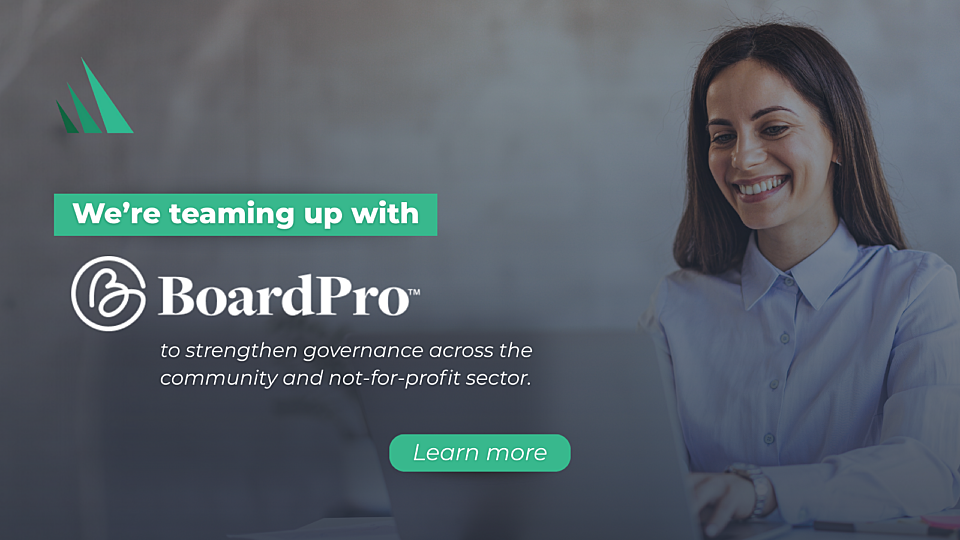
William Tilmouth wins Australia’s highest human rights award and condemns continuing Indigenous policies
Posted on 17 Dec 2025
The founding chair of the ambitious systems-change not-for-profit organisation Children’s Ground,…
Posted on 14 Jun 2025
By Irmke Bonte

Mergers in the in the not-for-profit sector are on the rise and while the benefits can be significant, such a decision should not be taken lightly, says Irmke Bonte, director of consulting at Social Ventures Australia.
Merger options should be a part of every not-for-profit’s (NFP’s) strategic discussions.
Here, we set out why, and outline how to think through whether a merger may be right for you.
The opportunity to increase impact for their clients should motivate NFPs to actively explore strategic opportunities for improvement, including mergers.
After a dip in NFP merger discussions due to the uncertainty driven by the pandemic and sector reforms, since 2020-21 merger discussions are steadily increasing.
The health and residential aged care sector stand out in particular with 33 per cent of NFPs in merger discussions in 2023 compared to 27 per cent for the broader NFP sector.
At Social Ventures Australia, we are often asked by NFPs we work with whether they should be considering a merger. Our answer is yes. While pursuing mergers comes with risks, when done successfully, the impact can be enormous.
Moreover, mergers can be a means to remain competitive with for-profit providers and to sustainably continue to deliver quality outcomes that often exceed that of for-profit.
The opportunity to increase, or sustain, their impact should motivate NFPs to include merger considerations as a standard topic in their strategic discussions – just as it is for for-profit organisations.
Pursuing a merger is the right choice if the merger will increase your impact.
To know whether pursuing a merger is the right move, we suggest considering the four questions below.
Importantly, reflecting on not only the current context, but also likely future scenarios – including a potentially much more consolidated and highly regulated sector.
Mergers can be risky, complicated and lengthy transactions with many moving parts to consider.
The overriding principle that needs to govern all trade-offs and decision-making is whether the merger will increase the impact that your organisation can achieve.
For this reason, the first question to ask is: what is the impact that you strive to create with your organisation?
When answering this question, it is important to be clear on how you can achieve your impact. What are your distinctive capabilities (what do you do exceptionally well) that enable you to achieve this impact?
For example, Reconciliation Australia exists to promote and facilitate reconciliation by building relationships, respect and trust between the wider Australian community and Aboriginal and Torres Strait Islander peoples.
They are uniquely positioned to do this, given (amongst other strengths) their distinctive capability to build trusted relationships with a large range of diverse organisations at different stages on their journey towards reconciliation.
The next step would be to understand how well you do in achieving your impact, and how this compares to others. This is often where it gets a little tricky.
NFPs typically measure success through impact metrics – such as number of people impacted and outcomes to those beneficiaries. These metrics differ greatly across organisations.
This lack of standardisation makes it hard to directly compare performance versus peers and identify areas where you excel and where you could improve.
However, even if the perspective is only indicative at first, knowing your main peers and understanding what they do better or less well than you are critical to understanding how you can better achieve your impact.
2. How would a merger help increase your impact?
Typically, there are three ways in which a merger may increase your impact (or sustain impact that you are challenged to maintain):
The contribution of each of these factors depends on how you achieve your impact, as well as how you compare to peers. The role of each of these factors would influence what form of merger and what potential merger partners would be suitable.
And of course, the ability to find a suitable partner and agree on the form of merger, will determine how much of these potential benefits you are able to realise.
If you are clear on what you do exceptionally well towards achieving your impact (and what you do less well), you will be able to articulate what capabilities or assets may enhance your ability to increase your impact.
You could perhaps expand a successful model geographically, strengthen both organisations with complementary capabilities, or grow your capabilities by sharing expertise and learning from a larger base of insights.
For example, the merger of Australian Unity and myHomecare will expand Australian Unity’s Home Health business to serve an additional approximately 20,000 customers.
Bringing two organisations together could create financial efficiencies by removing duplication and leveraging scale in support functions, such as administration and finance support, understanding implications of regulatory changes, quality assurance, government reporting, and rostering.
In addition, financial capacity could be created by avoiding duplication of future technological investments.
For many NFPs, customer experience, service quality and impact are directly linked to frontline/customer-facing support, therefore realising efficiencies in those teams is typically not an option.
Improved financial health would contribute to increasing your impact by supporting long-term financial sustainability and by enabling investments in service or product quality as well expanding the number or type of clients reached.
For example, the merger of House with No Steps and The Tipping Foundation into Aruma aimed to transform the organisations effectively and efficiently in response to changing dynamics in the disability sector.
In some cases, merging with another organisation may give an organisation a stronger advocacy position and more leverage to increase their impact.
This could be by making a stronger case to funders (including government, philanthropy, other donors) or by getting a seat at the table in critical policy and advocacy discussions.
For example, growing a stronger voice to champion sustainable solutions in the aged care market was one of the drivers for the merger of Baptcare (Vic, Tas, SA), Baptist Care SA and BaptistCare (NSW, ACT, WA) into BaptistCare, Australia’s third largest integrated care and service provider.
According to yearly Australian Institute of Company Directors (AICD) studies, primary drivers for NFP merger activity over the past few years have consistently been related to enhanced capability and capacity (better meeting mission, broadening the range of services, and increasing the number of people served).
Increasingly, elements related to improved financial health (financial sustainability pressures and insufficient resources) have become important drivers as well.
In 2020, these two financially related drivers didn’t make it into the top five reasons for mergers whereas, they took 2nd and 5th position in 2023.
"Successful mergers depend on the ability to check your ego at the door and stay focused on the larger purpose: increasing your impact."
3. How do the alternatives compare
Merging is not the only way to improve your impact, and it does come with a significant amount of risk and investment of resources.
Are there alternative strategies to achieve these outcomes?

For example, what efficiencies could be realised by improving internal back-office processes?
What would the organisation look like if you were to truly focus only on what you’re really good at, and divest other activities to other organisations who are better placed in those areas?
Are there other forms of partnership (for example setting up an association or joint service delivery) that could realise similar benefits to merging and come with lower risk?
Thinking through these questions will help you determine whether a merger is the most fitting pathway.
One of SVA’s clients sought support in exploring opportunities to improve their financial health through scale, including via mergers and acquisitions. As we assessed the financial performance of their various services, we identified inherent costs that would not be resolved by a merger.
As a result, the board decided to shift its focus to improving the inherent cost structures before considering expansion – which they have now accomplished.
4. What would it take to successfully execute?
Mergers are no small feat. They can be risky, multi-year journeys that require a significant amount of investment.
Success requires access to financial resources, a strong commitment from both (or all) organisations, and the right capabilities to lead the organisations through merger exploration and implementation.
Before launching into this journey, it is important to reflect on whether you have the required means to succeed. And, if on balance the effort would increase the impact of your merged organisation.
The costs associated with a merger are considerable and often span multiple years.
Major costs include investments in preparing for the merger (including external support such as legal advisory) as well as the costs of integrating the organisations and investing in benefit realisation.
NFPs, unlike for-profit organisations, typically lack the financial reserves needed to cover these expenses and require creative solutions, such as acquiring philanthropic support or impact investing.
While this is not yet common practice in Australia, it is increasingly so in countries such as the United States, with funders positively responding to strong cases for increased impact and value for money created by mergers.
Successfully executing a merger demands the right capabilities to manage the process – from initial exploration through to final execution.
This includes:
NFPs often don’t have in-house expertise in mergers and must source support externally.
Finally, merger success is only possible if boards and CEOs are deeply committed.
Firstly, it is important to be invested in the time commitment required, which can be significant.
Secondly, it is critical to be committed to set aside personal egos for the greater purpose. In most scenarios, board positions will be impacted and at least one CEO is likely to lose their role.
Moreover, considering structural changes like mergers can feel personal, especially for board members with long tenures and deep personal commitments to the organisation’s activities and ways of working.
Successful mergers depend on the ability to check your ego at the door and stay focused on the larger purpose: increasing your impact.
SVA are often asked by our clients whether they should be considering a merger.
Our answer is yes: the objective to increase impact should motivate NFPs to actively consider all strategic opportunities for improvement, including mergers.
Whether a merger is something to pursue can be assessed by the answers to the four questions above.
Merging is the right choice if it will increase the impact of your organisation.
This story was originally published by Social Ventures Australia

Posted on 17 Dec 2025
The founding chair of the ambitious systems-change not-for-profit organisation Children’s Ground,…

Posted on 17 Dec 2025
As we head into the holiday period, the number of Australians battling homelessness has hit crisis…

Posted on 17 Dec 2025
Posturing by the US president about Europe's immigration policies, even warnings of future…

Posted on 17 Dec 2025
For this final Community Advocate edition of the year, we reviewed a whole year’s worth of stories…

Posted on 16 Dec 2025
Lex Lynch spent more than two decades in the climate change and renewables field before last year…

Posted on 16 Dec 2025
As Australia prepares to welcome its one millionth refugee, human rights advocate and former…

Posted on 11 Dec 2025
Community Directors trainer Jon Staley knows from first-hand experience the cost of ignoring…

Posted on 10 Dec 2025
Adele Stowe-Lindner, Executive Director, Community Directors The Institute of Community Directors…

Posted on 10 Dec 2025
The Australia Institute has called on the federal government to force Australian businesses to be…

Posted on 10 Dec 2025
Economic empowerment is essential to enabling recovery, restoring agency and preventing future…
Posted on 10 Dec 2025
A long-time advocate for rough sleepers in northern New South Wales has been named her state’s…

Posted on 10 Dec 2025
What a year 2025 has been, particularly at a national level where the Parliament and politics as we…